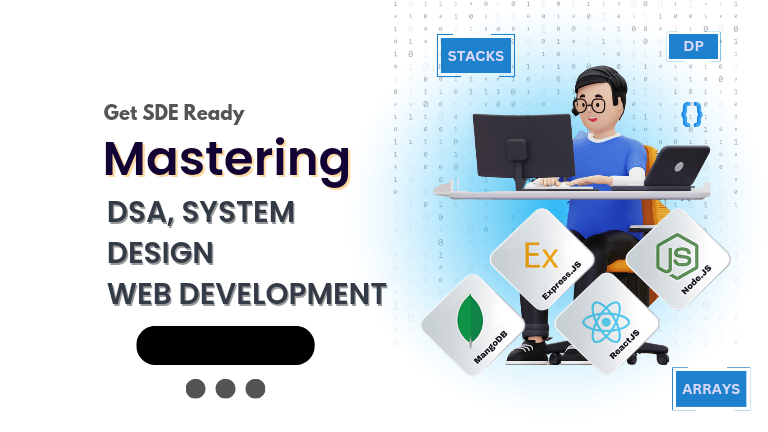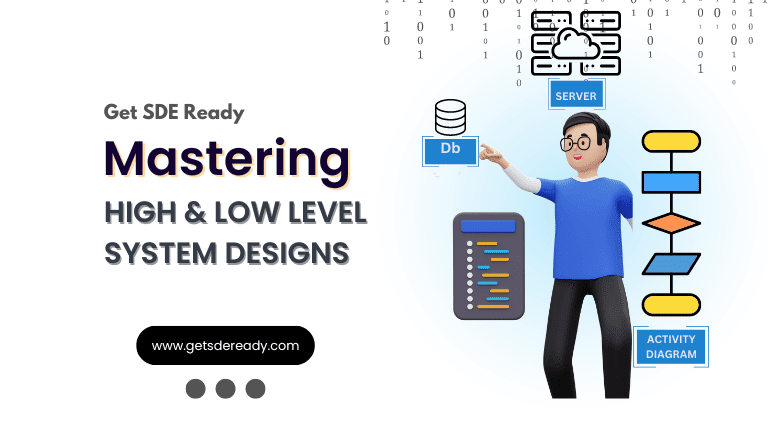Data Structures and Algorithms
- Introduction to Data Structures and Algorithms
- Time and Space Complexity Analysis
- Big-O, Big-Theta, and Big-Omega Notations
- Recursion and Backtracking
- Divide and Conquer Algorithm
- Dynamic Programming: Memoization vs. Tabulation
- Greedy Algorithms and Their Use Cases
- Understanding Arrays: Types and Operations
- Linear Search vs. Binary Search
- Sorting Algorithms: Bubble, Insertion, Selection, and Merge Sort
- QuickSort: Explanation and Implementation
- Heap Sort and Its Applications
- Counting Sort, Radix Sort, and Bucket Sort
- Hashing Techniques: Hash Tables and Collisions
- Open Addressing vs. Separate Chaining in Hashing
- DSA Questions for Beginners
- Advanced DSA Questions for Competitive Programming
- Top 10 DSA Questions to Crack Your Next Coding Test
- Top 50 DSA Questions Every Programmer Should Practice
- Top Atlassian DSA Interview Questions
- Top Amazon DSA Interview Questions
- Top Microsoft DSA Interview Questions
- Top Meta (Facebook) DSA Interview Questions
- Netflix DSA Interview Questions and Preparation Guide
- Top 20 DSA Interview Questions You Need to Know
- Top Uber DSA Interview Questions and Solutions
- Google DSA Interview Questions and How to Prepare
- Airbnb DSA Interview Questions and How to Solve Them
- Mobile App DSA Interview Questions and Solutions
DSA Interview Questions
- DSA Questions for Beginners
- Advanced DSA Questions for Competitive Programming
- Top 10 DSA Questions to Crack Your Next Coding Test
- Top 50 DSA Questions Every Programmer Should Practice
- Top Atlassian DSA Interview Questions
- Top Amazon DSA Interview Questions
- Top Microsoft DSA Interview Questions
- Top Meta (Facebook) DSA Interview Questions
- Netflix DSA Interview Questions and Preparation Guide
- Top 20 DSA Interview Questions You Need to Know
- Top Uber DSA Interview Questions and Solutions
- Google DSA Interview Questions and How to Prepare
- Airbnb DSA Interview Questions and How to Solve Them
- Mobile App DSA Interview Questions and Solutions
Data Structures and Algorithms
- Introduction to Data Structures and Algorithms
- Time and Space Complexity Analysis
- Big-O, Big-Theta, and Big-Omega Notations
- Recursion and Backtracking
- Divide and Conquer Algorithm
- Dynamic Programming: Memoization vs. Tabulation
- Greedy Algorithms and Their Use Cases
- Understanding Arrays: Types and Operations
- Linear Search vs. Binary Search
- Sorting Algorithms: Bubble, Insertion, Selection, and Merge Sort
- QuickSort: Explanation and Implementation
- Heap Sort and Its Applications
- Counting Sort, Radix Sort, and Bucket Sort
- Hashing Techniques: Hash Tables and Collisions
- Open Addressing vs. Separate Chaining in Hashing
- DSA Questions for Beginners
- Advanced DSA Questions for Competitive Programming
- Top 10 DSA Questions to Crack Your Next Coding Test
- Top 50 DSA Questions Every Programmer Should Practice
- Top Atlassian DSA Interview Questions
- Top Amazon DSA Interview Questions
- Top Microsoft DSA Interview Questions
- Top Meta (Facebook) DSA Interview Questions
- Netflix DSA Interview Questions and Preparation Guide
- Top 20 DSA Interview Questions You Need to Know
- Top Uber DSA Interview Questions and Solutions
- Google DSA Interview Questions and How to Prepare
- Airbnb DSA Interview Questions and How to Solve Them
- Mobile App DSA Interview Questions and Solutions
DSA Interview Questions
- DSA Questions for Beginners
- Advanced DSA Questions for Competitive Programming
- Top 10 DSA Questions to Crack Your Next Coding Test
- Top 50 DSA Questions Every Programmer Should Practice
- Top Atlassian DSA Interview Questions
- Top Amazon DSA Interview Questions
- Top Microsoft DSA Interview Questions
- Top Meta (Facebook) DSA Interview Questions
- Netflix DSA Interview Questions and Preparation Guide
- Top 20 DSA Interview Questions You Need to Know
- Top Uber DSA Interview Questions and Solutions
- Google DSA Interview Questions and How to Prepare
- Airbnb DSA Interview Questions and How to Solve Them
- Mobile App DSA Interview Questions and Solutions
LLM Infrastructure: How AI Models Are Deployed at Scale
Are you ready to transform your resume from ordinary to standout in the competitive tech job market? Building hands-on Data Structures and Algorithms (DSA) projects is one of the smartest ways to showcase your skills and demonstrate real-world problem-solving abilities. Whether you’re a beginner or an experienced developer, these projects can highlight your expertise in organizing data efficiently and optimizing code—key traits that recruiters at top companies look for. To kickstart your learning and stay updated with free resources, sign up for our newsletter to receive the latest course updates and exclusive access to free DSA tutorials.
In today’s job landscape, DSA proficiency is more crucial than ever. According to recent reports, employment for roles requiring strong algorithmic skills, such as data scientists, is projected to grow by 36% from 2023 to 2033, far outpacing average job growth. Additionally, 84% of tech employers report significant skills gaps, emphasizing the need for practical DSA experience. As software engineer Vivek Kumar notes, “Understanding DSA makes you a better problem solver. You can design solutions that are scalable and efficient.” This post dives deep into the top 10 DSA projects, complete with descriptions, implementation guidance, and tips to make them shine on your resume.
Why DSA Projects Matter for Your Resume
DSA projects aren’t just academic exercises—they’re proof of your ability to apply theoretical knowledge to practical scenarios. In software engineering interviews, especially at FAANG companies, DSA questions dominate because they test your foundational thinking. But beyond interviews, these projects show recruiters you can optimize code for efficiency, a skill that’s vital in real-time systems like e-commerce or financial apps.
The Impact on Career Growth
- Boosts Employability: Projects demonstrate hands-on experience, making your resume stand out. For instance, 72% of companies invest in upskilling, and DSA projects align perfectly with that demand.
- Real-World Relevance: As one expert puts it, DSA is the “base of every technology like Blockchain, Big Data, etc.” Building projects helps you understand these applications deeply.
- Interview Edge: Interviewers often probe project details, so having DSA-focused work can lead to discussions on algorithms you’ve implemented.
If you’re aiming to level up, consider enrolling in a structured program like our DSA course, which covers everything from basics to advanced implementations.
Statistics Highlighting DSA Demand
Here’s a quick table summarizing key stats on DSA and tech skills:
Statistic | Value | Source |
Projected growth for data scientists (requiring DSA) | 36% (2023-2033) | Cobloom |
Tech employers reporting skills gaps | 84% | SecondTalent |
Average salary for Machine Learning Engineers (DSA-heavy) | $168,730 (2025) | TowardsAI |
Growth in AI and data jobs despite market slowdown | Fast-growing | Computerworld |
These numbers underscore why incorporating DSA projects can fast-track your career.
How to Choose the Right DSA Project
Selecting a project should align with your skill level, interests, and career goals. Beginners might start with array-based games, while intermediates can tackle graph optimizations.
Factors to Consider
- Skill Level: Opt for beginner-friendly projects like Snake Game if you’re new, or advanced ones like Huffman Encoding for more challenge.
- Relevance: If targeting web roles, integrate DSA with front-end, perhaps through our web development course.
- Complexity: Aim for projects that demonstrate time/space efficiency—recruiters love O(n log n) implementations.
- Portfolio Fit: Choose ones with visual appeal, like visualizers, to make your GitHub pop.

Actionable advice: Start small, document your code, and host it on GitHub. For comprehensive learning, explore our master DSA, web dev, and system design course.
Top 10 DSA Projects
Let’s explore the top projects, each with in-depth explanations, DSA concepts, implementation steps, challenges, and resume tips. These are drawn from expert sources like Simplilearn, upGrad, and GUVI, ensuring they’re up-to-date for 2025.
1. Snake Game (Arrays/Linked Lists)
This classic game, popularized since 1998, involves a snake navigating a grid to eat food while avoiding collisions. It’s a fantastic beginner project that brings arrays to life.
Key DSA: Arrays for grid, linked lists for snake body (add/remove nodes dynamically).
Implementation:
- Create a 2D array for the board.
- Use a linked list: Head as snake’s tail, add nodes on food consumption.
- Handle input for directions, update positions in a loop.
- Check collisions with boundaries or self.
Challenges: Managing dynamic growth without performance lags; optimizing for smooth gameplay.
Why for Resume: Shows foundational data manipulation. As per experts, it reveals real-world DSA use in interactive apps. Add it to your portfolio to demonstrate game logic skills.
2. Sorting Visualizer (Sorting Algorithms)
Build an interactive tool that animates sorting algorithms like Bubble, Merge, or Quick Sort, helping users see efficiency in action.
Key DSA: Various sorting algos (O(n^2) to O(n log n)).
Implementation:
- Use HTML/CSS/JS for UI; arrays to hold data.
- Implement each sort with step-by-step visualization (color changes for swaps).
- Add controls for speed, array size, and algorithm selection.
- Use setTimeout for animation.
Challenges: Syncing visuals with algo steps; handling large arrays without browser lag.
Why for Resume: Visual projects stand out, proving algorithmic understanding. It’s ideal if you’re into data visualization—pair it with our data science course.
3. Sudoku Solver (Backtracking)
Solve 9×9 Sudoku puzzles automatically using trial-and-error backtracking.
Key DSA: 2D arrays, backtracking recursion.
Implementation:
- Represent grid as 2D array.
- Write isSafe() to check row/column/subgrid.
- Recurse: Try 1-9 in empty cells, backtrack on failure.
- Print solved grid.
Challenges: Avoiding stack overflow in recursion; optimizing for hard puzzles.
Why for Resume: Highlights constraint-solving prowess, common in AI interviews. “It helps in placements by showing algorithm awareness,” notes Simplilearn.
4. File Zipper (Huffman Coding)
Compress files losslessly by assigning shorter codes to frequent characters.
Key DSA: Binary trees, min-heaps (priority queues), greedy algo.
Implementation:
- Calculate char frequencies.
- Build min-heap, merge lowest freq nodes into tree.
- Traverse for codes (left=0, right=1).
- Encode file, store tree for decode.
Challenges: Bit-level manipulation; handling large files efficiently.
Why for Resume: Demonstrates optimization—vital for storage systems. Great for systems roles.
5. Map Navigator (Dijkstra’s Algorithm)
Find shortest paths in a graph, like a simple GPS.
Key DSA: Graphs (adjacency matrix), Dijkstra’s for weighted paths.
Implementation:
- Build graph with nodes (locations), edges (distances).
- Init distance array, use minDistance to pick nodes.
- Update neighbors if shorter path found.
- Output paths/distances.
Challenges: Handling negative weights (use Bellman-Ford variant); scaling for large graphs.
Why for Resume: Real-world like Google Maps; shows pathfinding skills.
6. Cash Flow Minimiser (Graphs/Heaps)
Optimize transactions in a group to reduce net cash flow.
Key DSA: Graphs for debts, multisets/heaps for balances, greedy settlement.
Implementation:
- Model as graph with weighted edges.
- Use multiset for net balances.
- Recurse: Match max creditor/debtor, adjust.
- Print minimized transactions.
Challenges: Handling cycles; ensuring minimal steps.
Why for Resume: Fintech-relevant; proves graph optimization.
7. Maze Solver (BFS/DFS)
Navigate and solve mazes using search algorithms.
Key DSA: Graphs, BFS/DFS for traversal, backtracking.
Implementation:
- Represent maze as 2D grid graph.
- Start BFS/DFS from entry, mark visited.
- Backtrack on dead ends.
- Output path.
Challenges: Memory for large mazes; visualizing paths.
Why for Resume: Classic search demo; useful for game dev.
8. URL Shortener (Hashing)
Create short links from long URLs with tracking.
Key DSA: Hash tables for mapping, stacks for expiration.
Implementation:
- Hash long URL to short key.
- Store in hash map.
- Redirect on access; stack for cleanup.
- Add analytics.
Challenges: Collision resolution; unique keys.
Why for Resume: Web service example; integrate with crash course.
9. LRU Cache Implementation
Simulate least recently used cache eviction.
Key DSA: Doubly linked list + hash map for O(1) operations.
Implementation:
- Hash map for key-node lookup.
- Doubly list: Move accessed to front.
- Evict tail on full.
- Get/put methods.
Challenges: Thread-safety; edge cases.
Why for Resume: System design staple; shows efficiency.

10. Predictive Text Input (Trie)
Autocomplete words using prefix trees.
Key DSA: Trie for string storage/search.
Implementation:
- Trie nodes with children array.
- Insert words.
- Search prefixes, suggest completions.
- Flag word ends.
Challenges: Large dictionaries; fuzzy matching.
Why for Resume: UI-relevant; enhances NLP skills.
Tips for Building and Showcasing Your DSA Projects
- Document Thoroughly: Include READMEs with DSA explanations, complexities.
- Optimize Code: Analyze time/space, refactor.
- Host Online: GitHub with demos.
- Common Mistakes to Avoid: Skipping tests, ignoring edge cases, overcomplicating.
For quick starts, try our crash course.
Conclusion
Incorporating these DSA projects into your resume can significantly boost your profile, proving you’re not just theoretical but practically skilled. Start with one today—perhaps the Snake Game—and build from there. Remember, as Vivek Kumar says, DSA combined with projects makes you “unstoppable.” Ready to dive deeper? Explore our courses and take action now!
(Word count: approx. 2,100)
FAQs
What are the best DSA projects for beginners to add to their resume?
Beginner-friendly DSA projects like Snake Game or Sudoku Solver using arrays and backtracking are ideal, demonstrating foundational skills without overwhelming complexity.
How do DSA projects improve your chances in software engineering interviews?
DSA projects showcase practical algorithm application, helping you explain concepts during interviews and addressing the 84% tech skills gap reported by employers.
Which data structures are most commonly used in resume-boosting projects?
Arrays, linked lists, graphs, heaps, and trees are prevalent in projects like sorting visualizers and map navigators, highlighting efficiency in real-world scenarios.
Can DSA projects help transition to data science roles?
Yes, projects involving heaps or graphs, such as stock analysis, align with data science demands, where jobs are growing 36% through 2033.

DSA, High & Low Level System Designs
- 85+ Live Classes & Recordings
- 24*7 Live Doubt Support
- 400+ DSA Practice Questions
- Comprehensive Notes
- HackerRank Tests & Quizzes
- Topic-wise Quizzes
- Case Studies
- Access to Global Peer Community
Buy for 52% OFF
₹25,000.00 ₹11,999.00
Accelerate your Path to a Product based Career
Boost your career or get hired at top product-based companies by joining our expertly crafted courses. Gain practical skills and real-world knowledge to help you succeed.

SDE 360: Master DSA, System Design, AI & Behavioural
- 100+ Live Classes & Recordings
- 24*7 Live Doubt Support
- 400+ DSA Practice Questions
- Comprehensive Notes
- HackerRank Tests & Quizzes
- Topic-wise Quizzes
- Case Studies
- Access to Global Peer Community
Buy for 50% OFF
₹39,999.00 ₹19,999.00

DSA, High & Low Level System Designs
- 85+ Live Classes & Recordings
- 24*7 Live Doubt Support
- 400+ DSA Practice Questions
- Comprehensive Notes
- HackerRank Tests & Quizzes
- Topic-wise Quizzes
- Case Studies
- Access to Global Peer Community
Buy for 52% OFF
₹25,000.00 ₹11,999.00

Fast-Track to Full Spectrum Software Engineering
- 120+ Live Classes & Recordings
- 24*7 Live Doubt Support
- 400+ DSA Practice Questions
- Comprehensive Notes
- HackerRank Tests & Quizzes
- 12+ live Projects & Deployments
- Case Studies
- Access to Global Peer Community
Buy for 51% OFF
₹35,000.00 ₹16,999.00

Low & High Level System Design
- 20+ Live Classes & Recordings
- 24*7 Live Doubt Support
- Case Studies
- Comprehensive Notes
- HackerRank Tests
- Topic-wise Quizzes
- Access to Global Peer Community
- Interview Prep Material
Buy for 60% OFF
₹20,000.00 ₹7,999.00

Mastering Mern Stack (WEB DEVELOPMENT)
- 65+ Live Classes & Recordings
- 24*7 Live Doubt Support
- 12+ Hands-on Live Projects & Deployments
- Comprehensive Notes & Quizzes
- Real-world Tools & Technologies
- Access to Global Peer Community
- Interview Prep Material
- Placement Assistance
Buy for 53% OFF
₹15,000.00 ₹6,999.00
Reach Out Now
If you have any queries, please fill out this form. We will surely reach out to you.
Contact Email
Reach us at the following email address.
arun@getsdeready.com
Phone Number
You can reach us by phone as well.
+91-97737 28034
Our Location
Rohini, Sector-3, Delhi-110085
